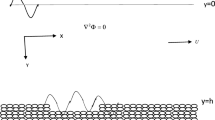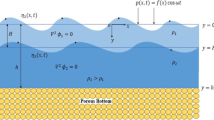Abstract
Experimental data are given on wave shapes and propagation speeds and characteristic headwater and tailwater depths after removal of a shield producing an initial free-surface level drop and located above a bottom drop in a rectangular open channel. Check is performed of self-similar solutions of the problem obtained earlier using a hydraulic approximation. It has been established that in certain ranges of time, longitudinal coordinate, and problem parameters, these solutions are supported by experimental results.
Similar content being viewed by others
REFERENCES
A. A. Atavin, M. T. Gladyshev, and S. M. Shugrin, “Discontinuous ows in open channels,” in: Dynamics of Continuous Media (collected scientific papers) [in Russian], No. 22, Novosibirsk (1975), pp. 37–64.
R. F. Dressler, “Comparison of theories and experiments for the hydraulic dam-break wave,” Int. Assoc. Sci. Hydrology, 3, No. 38, 319–328 (1954).
J. J. Stoker, Water Waves. The Mathematical Theory with Applications, Interscience Publ., New York-London (1957).
F. Alcrudo and F. Benkhaldon, “Exact solutions to the Riemann problem of shallow water equations with bottom step,” Comput. Fluids, 30, 643–671 (2001).
V. V. Ostapenko, “Discontinuous solutions of the shallow water equations for ow over a bottom step,” J. Appl. Mech. Tech. Phys., 43, No. 6, 836–874 (2002).
A. A. Atavin and O. F. Vasil’ev, “Possible consequences of accidents at ship locks due to penstock failure,” in: Hydraulic and Hydrological Aspects of Reliability and Safety Assessment of Hydraulic Structures, Abstracts of Int. Symp. (St. Petersburg, May 28-June 1, 2002), Inst. of Hydraulic Engineering, St. Petersburg (2002), p. 121.
V. A. Prokof’ev, Modern numerical schemes based on the control volume method for simulating rapid ows and dam-break waves,” Gidrotekh. Stroit., 7, 22–29 (2002).
V. I. Bukreev and A. V. Gusev, “Reection of a dam-break wave from a vertical wall,” in: Trans. Novosib. State Architectural University, Vol. 3, No. 2 (2000), pp. 47–59.
V. B. Barakhnin, T. V. Krasnoshchekova, and I. N. Potapov, “Reection of a dam-break wave at a vertical wall. Numerical modeling and experiment,” J. Appl. Mech. Tech. Phys., 42, No. 2, 269–276 (2001).
V. I. Bukreev, “Water impingement on a vertical wall due to discontinuity decay above a drop,” J. Appl. Mech. Tech. Phys., 44, No. 1, 59–63 (2003).
V. I. Bukreev and A. V. Gusev, “Waves behind a step in an open channel,” J. Appl. Mech. Tech. Phys., 44, No. 1, 52–58 (2003).
V. I. Bukreev and A. V. Gusev, “Waves in a channel ahead of a vertical plate,” Izv. Ross. Akad. Nauk, Mekh. Zhidk. Gaza, 1, 82–90 (1999).
P. G. Kiselev, Handbook on Hydraulic Calculations [in Russian], Gosénergoizdat (1957).
V. I. Bukreev and A. V. Gusev, “Cavities behind a spillway with a wide sill,” J. Appl. Mech. Tech. Phys., 43, No. 2, 280–285 (2002).
V. Yu. Liapidevskii and V. M. Teshukov, Mathematical Models of Long-Wave Propagation in Inhomogeneous Liquids [in Russian], Izd. Sib. Otdel. Ross. Akad. Nauk, Novosibirsk (2000).
Author information
Authors and Affiliations
Rights and permissions
About this article
Cite this article
Bukreev, V.I., Gusev, A.V. Gravity Waves due to Discontinuity Decay Over an Open-Channel Bottom Drop. Journal of Applied Mechanics and Technical Physics 44, 506–515 (2003). https://doi.org/10.1023/A:1024244907059
Issue Date:
DOI: https://doi.org/10.1023/A:1024244907059




